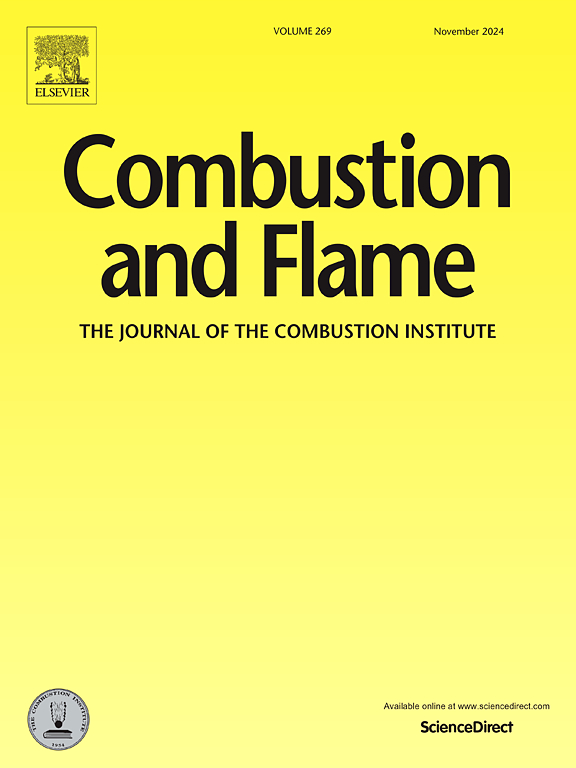Theoretical study of the real-fluid laminar flame propagation under supercritical conditions by using the virial equation of state and the Enskog transport model
IF 5.8
2区 工程技术
Q2 ENERGY & FUELS
引用次数: 0
Abstract
A real-fluid computation model using the Virial equation of state and the Enskog transport model was developed in this work to simulate real-fluid laminar flame propagations, and it was also compared with the Redlich-Kwong-Ely-Hanley/Takahashi real-fluid model in literature. The real-fluid effects of equation of state, thermodynamics, chemical potential, thermal conductivity, and mass diffusion have been investigated on the freely propagating flame simulations of different fuels. The contribution and the source of uncertainties by different real-fluid properties are also comprehensively discussed. The overall effects of real-fluid behaviors on the laminar flame speed simulations in H2O-dilute mixtures can reach 35 % at 100 atm, which reveal that accurate descriptions of real-fluid effects are crucial for flame speed predictions, especially using dilute gas with a high polarization, such as H2O. The Redlich-Kwong-Ely-Hanley/Takahashi model shows severe over-predictions of the hydrogen laminar flame speeds due to its significant weakness in predictions of thermal conductivities of mixtures by comparing with the NIST data, while the present Virial-Enskog model exhibits more reasonable predictability. The real-fluid simulations of the laminar flame speeds of DME and n-heptane flames by using the Virial-Enskog model and the Redlich-Kwong-Ely-Hanley/Takahashi model are compared with the available experimental data. It shows a crucial real-fluid effect on the simulations of DME and n-heptane flame speeds, up to 8 % discrepancy from the ideal-gas flame speed prediction, even at 20–25 atm. Overall, the Virial-Enskog model provides better estimations of the real-fluid behaviors than the empirical Redlich-Kwong-Ely-Hanley/Takahashi model, especially at high pressures.
利用维里状态方程和Enskog输运模型对超临界条件下真实流体层流火焰传播进行了理论研究
本文建立了基于Virial状态方程和Enskog输运模型的真实流体计算模型来模拟真实流体层流火焰的传播,并与文献中的Redlich-Kwong-Ely-Hanley/Takahashi真实流体模型进行了比较。研究了状态方程、热力学、化学势、导热系数和质量扩散对不同燃料自由传播火焰模拟的实流体效应。本文还全面讨论了不同实际流体性质对不确定性的贡献和来源。在100大气压下,真实流体行为对水-稀混合物层流火焰速度模拟的总体影响可达35%,这表明准确描述真实流体效应对火焰速度预测至关重要,特别是在高极化的稀气体(如水)中。与NIST的数据相比,Redlich-Kwong-Ely-Hanley/Takahashi模型对氢层流火焰速度的预测存在严重的过度,这是由于它在预测混合物导热系数方面存在明显的不足,而目前的Virial-Enskog模型显示出更合理的可预测性。采用Virial-Enskog模型和Redlich-Kwong-Ely-Hanley/Takahashi模型对二甲醚和正庚烷火焰层流速度进行了实流模拟,并与已有实验数据进行了比较。它显示了对二甲醚和正庚烷火焰速度模拟的关键的真实流体效应,即使在20-25大气压下,与理想气体火焰速度预测的差异也高达8%。总的来说,Virial-Enskog模型比经验的Redlich-Kwong-Ely-Hanley/Takahashi模型提供了更好的真实流体行为估计,特别是在高压下。
本文章由计算机程序翻译,如有差异,请以英文原文为准。
求助全文
约1分钟内获得全文
求助全文
来源期刊

Combustion and Flame
工程技术-工程:化工
CiteScore
9.50
自引率
20.50%
发文量
631
审稿时长
3.8 months
期刊介绍:
The mission of the journal is to publish high quality work from experimental, theoretical, and computational investigations on the fundamentals of combustion phenomena and closely allied matters. While submissions in all pertinent areas are welcomed, past and recent focus of the journal has been on:
Development and validation of reaction kinetics, reduction of reaction mechanisms and modeling of combustion systems, including:
Conventional, alternative and surrogate fuels;
Pollutants;
Particulate and aerosol formation and abatement;
Heterogeneous processes.
Experimental, theoretical, and computational studies of laminar and turbulent combustion phenomena, including:
Premixed and non-premixed flames;
Ignition and extinction phenomena;
Flame propagation;
Flame structure;
Instabilities and swirl;
Flame spread;
Multi-phase reactants.
Advances in diagnostic and computational methods in combustion, including:
Measurement and simulation of scalar and vector properties;
Novel techniques;
State-of-the art applications.
Fundamental investigations of combustion technologies and systems, including:
Internal combustion engines;
Gas turbines;
Small- and large-scale stationary combustion and power generation;
Catalytic combustion;
Combustion synthesis;
Combustion under extreme conditions;
New concepts.
 求助内容:
求助内容: 应助结果提醒方式:
应助结果提醒方式:


